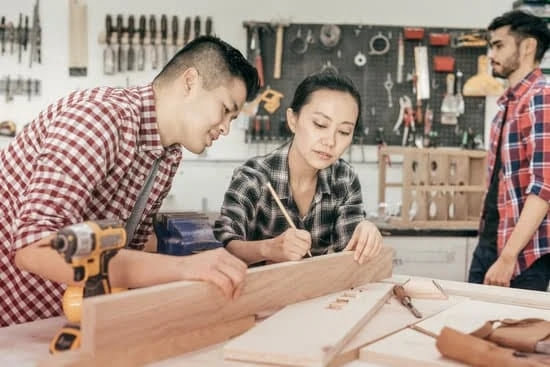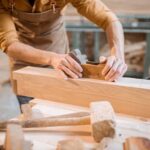Are you looking to enhance your woodworking skills and create a beautiful table for your home? In this article, we will discuss how to build a woodworking table from scratch. Woodworking tables are not only functional pieces of furniture but also serve as a creative outlet for DIY enthusiasts. Before diving into the project, it is essential to understand the basics of woodworking tables, including their purpose and construction.
When embarking on a woodworking table project, one of the first steps is selecting the right materials. The type of wood you choose will impact the overall look and durability of your table. Additionally, considering factors such as size, shape, and style will help determine the design that best fits your space. With numerous options available, it’s important to carefully plan and choose materials that align with your vision for the finished product.
In addition to materials, having the necessary tools and equipment is crucial for successfully building a woodworking table. From saws and drills to clamps and sandpaper, each tool plays a vital role in the construction process. Understanding how to properly use these tools and following safety guidelines is essential for completing the project efficiently and accurately. By investing in quality tools and familiarizing yourself with their functions, you can ensure a smooth building experience.
Selecting the Right Materials for Your Woodworking Table Project
When embarking on a woodworking table project, one of the most crucial decisions you will make is selecting the right materials. The type and quality of materials you choose will greatly impact the final look, durability, and overall performance of your woodworking table. Here are some key considerations when choosing materials for your woodworking table project.
Wood Selection
The type of wood you select for your woodworking table will determine its appearance, strength, and cost. Hardwoods like oak, maple, cherry, and walnut are popular choices due to their durability and attractive grain patterns. Softwoods like pine and cedar are more affordable options but may not be as resistant to wear and tear. Consider the aesthetic you want to achieve and the level of maintenance you are willing to commit to when choosing wood for your project.
Hardware and Fasteners
In addition to wood, you will need a variety of hardware and fasteners to assemble your woodworking table. This includes screws, nails, bolts, nuts, washers, braces, brackets, hinges, drawer slides, and more. Make sure to choose high-quality hardware that is appropriate for the size and weight capacity of your woodworking table design. Stainless steel or brass hardware are good choices for longevity and corrosion resistance.
Finishing Materials
Lastly, don’t forget about finishing materials like stains, paints, sealants, and polyurethane coatings for your woodworking table. These products can enhance the natural beauty of the wood while protecting it from moisture, heat, scratches, and UV damage. Select a finish that complements the style of your woodworking table and provides the level of protection necessary for its intended use. Be sure to follow manufacturer instructions for proper application and drying times to achieve professional results in your woodworking project.
By carefully selecting the right materials for your woodworking table project based on factors like wood type, hardware quality, and finishing products compatibility can ensure a successful outcome with a durable piece that showcases craftsmanship and creativity in every detail.
Choosing the Perfect Design for Your Woodworking Table
When it comes to choosing the perfect design for your woodworking table, there are several factors to consider. The design of your woodworking table can greatly impact its functionality, style, and overall appeal. Here are some tips on how to select the right design for your project:
- Consider the size and shape: Determine the dimensions of the space where you plan to place the woodworking table. This will help you choose a design that fits well in the intended location.
- Think about the purpose: Are you building a workbench for heavy-duty projects or a dining table for family gatherings? The intended use of the table will influence its design.
- Explore different styles: From traditional farmhouse tables to modern minimalist designs, there are countless styles to choose from. Consider your personal preference and existing decor when selecting a design.
When selecting a design for your woodworking table, it’s also important to think about the construction method and complexity of the project. Some designs may require advanced woodworking skills and tools, while others are more beginner-friendly. Take into account your skill level and available resources before deciding on a specific design.
Ultimately, the perfect design for your woodworking table is one that meets your needs, complements your space, and aligns with your personal style. Whether you opt for a simple trestle table or a sophisticated coffee table with intricate details, make sure to carefully plan out your project before starting construction. With proper research and preparation, you can create a beautiful and functional woodworking table that you’ll be proud to showcase in your home.
Essential Tools and Equipment Needed for Building a Woodworking Table
Building a woodworking table requires the use of specific tools and equipment to ensure a successful project. Here is a list of essential items you will need:
- Measuring tools: A tape measure, combination square, and straight edge are essential for precise measurements and marking on the wood.
- Cutting tools: A circular saw, jigsaw, or table saw will be needed to cut the wood to the desired dimensions.
- Joinery tools: Depending on your chosen design, you may need a pocket hole jig, doweling jig, or biscuit joiner for creating strong joints in your woodworking table.
- Sanding tools: An orbital sander or sanding block will be necessary to create a smooth finish on the wood before assembly.
- Clamps and vices: These tools are crucial for holding pieces together securely while glue dries and during assembly.
In addition to these basic tools, safety gear such as goggles, ear protection, and a dust mask should always be worn when working with power tools. It is also important to have a well-ventilated workspace with proper lighting to ensure precision and safety throughout the building process.
When starting your project on how to build a woodworking table, having the right tools and equipment at hand will make the process more efficient and enjoyable. Investing in quality tools will not only result in a better finished product but also make future woodworking projects easier to tackle. Researching different brands and types of tools before purchasing them can help you make informed decisions based on your budget and project requirements.
Step-by-Step Guide on How to Build a Woodworking Table From Scratch
Building a woodworking table from scratch is a rewarding project that allows you to create a custom piece of furniture to suit your needs and style. Before you start, it is important to gather all the necessary tools and materials. The first step in building a woodworking table is to decide on the dimensions of the table based on your space requirements. Consider the height, width, and length of the table to ensure it fits perfectly in your desired location.
Once you have determined the dimensions, you can start by cutting the wood for the tabletop and legs according to your measurements. Use a sawhorse or workbench to support the wood while cutting and make sure to wear safety goggles for protection. Next, assemble the tabletop using wood glue and screws, ensuring that it is sturdy and level. Attach the legs to the tabletop using brackets or dowels for added stability.
After assembling the basic structure of your woodworking table, sand down any rough edges or surfaces to create a smooth finish. You can then choose whether to stain, paint, or seal your table based on your preference. Staining will enhance the natural beauty of the wood, painting allows for custom colors, while sealing provides protection against daily wear and tear. Finally, add any finishing touches such as drawer pulls or decorative elements to complete your woodworking table project.
| Tools Needed | Materials Needed |
|---|---|
| Saw (circular saw or hand saw) | Wood boards (plywood, hardwood) |
| Drill | Wood glue |
| Screws | Stain/paint/sealer |
Finishing Touches
When it comes to finishing your woodworking table, there are several options to consider – staining, painting, or sealing. Each method has its own advantages and can give your table a unique look and feel. Staining is a popular choice as it enhances the natural grain of the wood while adding color. There are various types of wood stains available in different shades, so you can choose one that matches your style and preferences.
Painting is another option for finishing your woodworking table. This allows you to add a pop of color to your piece and can help protect the wood from moisture and wear. Before painting, make sure to sand the table thoroughly to create a smooth surface for better paint adhesion. You can also use primer before applying the paint for a more durable finish.
Sealing your woodworking table is essential to protect it from spills, scratches, and other damage. There are different types of sealants such as polyurethane, varnish, and lacquer that offer varying levels of protection and sheen. Apply multiple coats of sealant, allowing each coat to dry completely before adding the next one. This will ensure that your woodworking table stays looking great for years to come.
| Finishing Method | Advantages |
|---|---|
| Staining | Enhances natural grain, adds color |
| Painting | Adds color, protects from moisture |
| Sealing | Protects from spills, scratches, and damage |
Tips and Tricks for Assembling and Gluing Your Woodworking Table
Assembling and gluing are critical steps in building a woodworking table as they ensure the structural integrity and stability of the final product. Proper assembly and gluing techniques can make a significant difference in the overall quality of your woodworking table. Here are some tips and tricks to help you achieve a strong and durable woodworking table:
Dry Fit Before Gluing
Before applying any glue, it’s crucial to do a dry fit of all the components of your woodworking table. This means assembling the pieces without any adhesive to ensure they fit together perfectly. Make any necessary adjustments before moving on to the gluing process.
Use Clamps for Secure Assembly
When it comes time to glue your woodworking table together, it’s essential to use clamps to hold everything in place while the adhesive dries. Clamps will help create even pressure across all joints, resulting in a stronger bond.
Apply Glue Evenly
It’s important to apply glue evenly on both surfaces that will be joined together. Use a brush or roller to spread the adhesive evenly, ensuring full coverage for a secure bond. Avoid using too much glue as it can lead to messy excess squeezing out once clamped.
By following these tips and tricks for assembling and gluing your woodworking table, you can ensure a solid and long-lasting piece of furniture that you can be proud of. Remember that proper assembly techniques can make all the difference in creating a high-quality woodworking table that will stand the test of time.
Troubleshooting Common Issues When Building a Woodworking Table
When embarking on the journey of building a woodworking table from scratch, it is important to anticipate and address common issues that may arise during the construction process. One common issue that woodworkers often encounter is warping or bowing of the tabletop after assembly.
This can be caused by uneven pressure applied during clamping or insufficient drying time for glued components. To prevent this issue, make sure to evenly distribute clamping pressure across the entire surface and allow ample time for the glue to fully cure before moving on to the next step.
Another common problem faced when building a woodworking table is gaps or inconsistencies in joints and seams. This can occur due to inaccuracies in measurements, improper cutting techniques, or uneven surfaces.
To avoid this issue, double-check all measurements before making cuts, use precision tools such as a square and level, and take the time to properly prepare and flatten any surfaces that will be joined together. Additionally, using wood filler or shims can help fill in small gaps and create a seamless finish.
Lastly, ensuring stability and durability of your woodworking table is crucial. If you find that your table wobbles or feels unsteady after assembly, it may be due to uneven leg length or improper attachment of the legs to the tabletop. To remedy this issue, carefully measure and adjust each leg to ensure they are all the same length and securely fasten them to the tabletop with appropriate hardware.
Additionally, adding braces or cross supports underneath the tabletop can further strengthen its structure and prevent any potential wobbling. By addressing these common issues proactively, you can overcome challenges during the building process and create a sturdy woodworking table that will stand the test of time.
Conclusion
In conclusion, building a woodworking table can be a rewarding and fulfilling project for any DIY enthusiast or woodworking hobbyist. By following the step-by-step guide provided in this article and using the right materials, tools, and techniques, you can create a functional and stylish table that will surely be a centerpiece in your home or workshop.
Whether you choose a simple design or a more intricate one, the process of building a woodworking table allows you to showcase your creativity and woodworking skills.
Once you have completed your woodworking table project, it is important to take the time to appreciate your hard work and dedication. Showcasing your finished table proudly in your home or workspace not only provides a sense of accomplishment but also serves as a reminder of what you are capable of creating with your own two hands.
Additionally, sharing your experience with others who may be interested in learning how to build a woodworking table can inspire and motivate them to embark on their own woodworking journey.
Overall, building a woodworking table is not just about creating furniture-it is about honing your skills, unleashing your creativity, and enjoying the process of working with wood. Whether you are a seasoned woodworker or a beginner looking to try something new, the satisfaction of completing a woodworking table project is unparalleled. So gather your materials, set up your tools, and get ready to bring your vision to life by learning how to build a woodworking table today.
Frequently Asked Questions
Is It Cheaper to Buy or Build a Workbench?
Whether it is cheaper to buy or build a workbench depends on various factors such as the quality of materials used, your woodworking skills, and the tools you already own. Building a workbench yourself can be cost-effective if you are able to source affordable materials and customize it to your specific needs.
What Kind of 2×4 for Workbench?
When choosing the kind of 2×4 for a workbench, it is important to consider the strength and durability of the wood. Selecting high-quality straight-grain lumber like Douglas fir or southern yellow pine can provide a sturdy foundation for your workbench. Avoid warped or knotty pieces that may compromise stability.
What Is the Best Wood for a Workbench Top?
The best wood for a workbench top is typically hardwoods like oak, maple, or birch due to their durability and resistance to wear and tear. These dense woods can withstand heavy use in a workshop environment and provide a smooth surface for various projects.
Consider the weight-bearing capacity and longevity of the wood when selecting material for your workbench top.

Hi everyone! I’m a woodworker and blogger, and this is my woodworking blog. In my blog, I share tips and tricks for woodworkers of all skill levels, as well as project ideas that you can try yourself.





